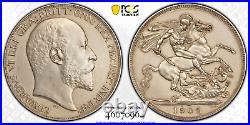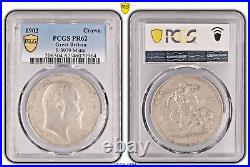


1902, Great Britain, Edward VII. Rare Matte Proof Silver Crown Coin. Mint Year: 1902 Denomination: Crown Mintage: 15,000 pcs. References: Davenport 109, KM-803. Certified and graded by PCGS as PR-62! 925 Weight: 28.26gm Diameter: 38mm. Obverse: Head of Edward VII right. Legend: EDWARD VII D:G BRITT : OMN : REX F : D : IND : IMP. George, wearing Attic helmet, right on horse, holding sword in preparation to dispatch prostrate and wounded Dragon below. Broken shaft of lance to left on ground, engraver´s initials B. Below ground to right. (May 29, 1783 – September 16, 1855) was a talented engraver of gemstones, cameos, coins and medals. Born in Italy, he moved to London in 1815 and was employed at the Royal Mint as an engraver, where his most famous work is his portrayal of St. George & the Dragon used on British gold sovereigns and crowns first created during the Great Recoinage of 1816. He also engraved the dies for many other coins, medals, and medallions, including the Waterloo Medal, which took him over thirty years to complete. He refused to copy the work of any other artist or engraver, and insisted that all his work was his own original work. Because of his Italian origin, he was not officially recognised as the chief engraver at the Royal Mint, and there were rivalries with other engravers including the Wyon family. Edward VII (Albert Edward; 9 November 1841 – 6 May 1910) was King of the United Kingdom and the British Dominions and Emperor of India from 22 January 1901 until his death on 6 May 1910. He was the first British monarch of the House of Saxe-Coburg-Gotha, which was renamed the House of Windsor by his son, George V. Before his accession to the throne, Edward held the title of Prince of Wales and was heir apparent to the throne for longer than anyone else in history. During the long widowhood of his mother, Queen Victoria, he was largely excluded from political power and came to personify the fashionable, leisured elite. The Edwardian period, which covered Edward’s reign and was named after him, coincided with the start of a new century and heralded significant changes in technology and society, including powered flight and the rise of socialism and the Labour movement. Edward played a role in the modernisation of the British Home Fleet, the reform of the Army Medical Services, and the reorganisation of the British army after the Second Boer War. His work in fostering good relations between Great Britain and other European countries, especially France, for which he was popularly called “Peacemaker”, was unable to prevent the outbreak of World War I in 1914.
